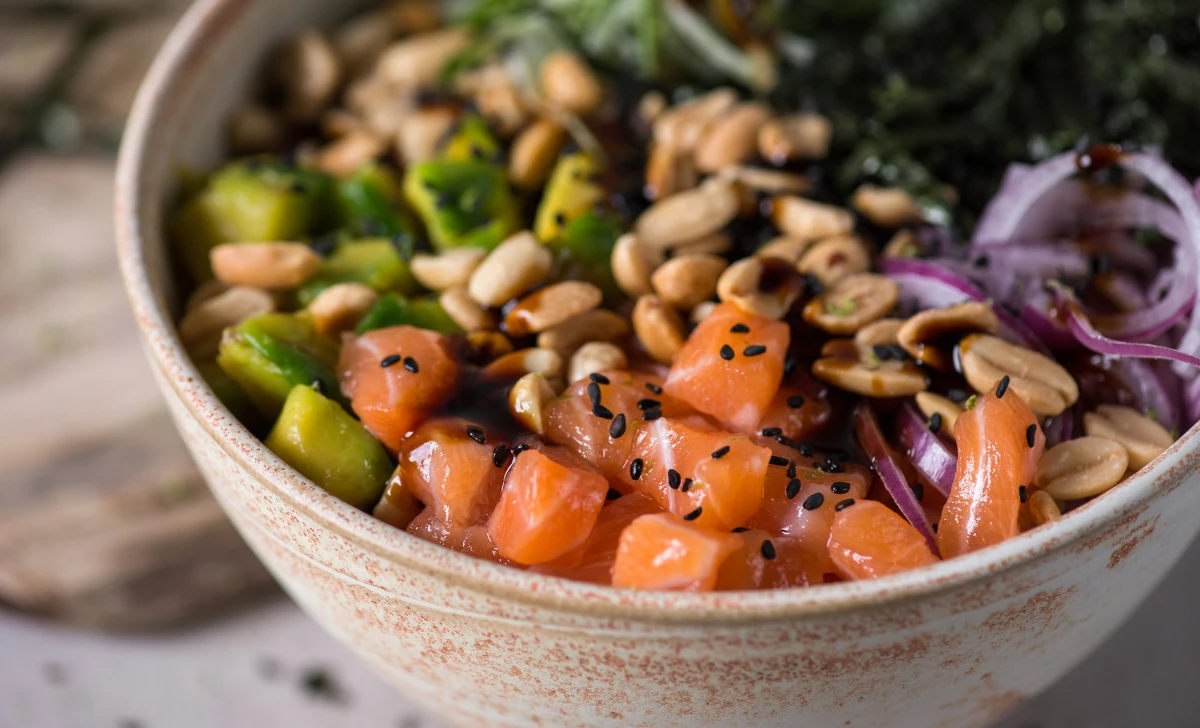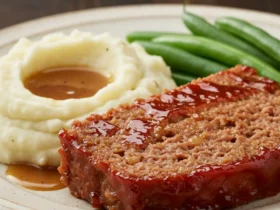Poke, pronounced “poh-kay,” is a traditional Hawaiian dish that has gained popularity worldwide in recent years. This delectable seafood salad is made with fresh raw fish, typically tuna, marinated in a flavorful combination of soy sauce, sesame oil, and various seasonings. The dish offers a delightful burst of flavors, textures, and colors that make it a perfect choice for those looking for a light and healthy meal. In this article, we will explore the history of poke, its ingredients, preparation methods, and some exciting variations to try. So, let’s dive into the world of poke and learn how to create this tantalizing dish in the comfort of your own kitchen!
[ez-toc]
History
Poke has a rich and fascinating history that spans centuries and cultures. Let’s delve deeper into its origins and discover some interesting facts and trivia about this beloved Hawaiian dish.
Ancient Polynesian Roots
The roots of poke can be traced back to the ancient Polynesians, who were skilled fishermen and navigators. They relied on the bounties of the ocean for sustenance and devised creative ways to preserve their catch during long voyages. The practice of slicing and seasoning fish to prolong its freshness and enhance its flavor can be seen as the precursor to modern-day poke.
Japanese Influence
The history of poke took an exciting turn with the arrival of Japanese immigrants in Hawaii during the late 19th century. These immigrants brought with them their culinary traditions, including their love for raw fish. They introduced new ingredients and flavors to the local cuisine, incorporating soy sauce, sesame oil, and other Asian elements into the traditional poke recipe. This fusion of Hawaiian and Japanese influences laid the foundation for the poke we know today.
Evolution and Popularity
For many years, poke remained a local delicacy enjoyed primarily by native Hawaiians and residents of the islands. However, in recent decades, it has gained immense popularity worldwide. The globalization of food trends, the rise of sushi culture, and the growing demand for fresh, healthy, and customizable dishes have all contributed to the poke revolution.
Time
| Step | Time (Approximate) |
|---|---|
| Choose and Prepare the Fish | 15-20 minutes |
| Prepare the Marinade | 5 minutes |
| Dice the Fish | 10 minutes |
| Marinate the Fish | 15-30 minutes |
| Prepare Toppings | 10-15 minutes |
| Assemble the Poke Bowl | 5-10 minutes |
| Total Cooking Time | 60-90 minutes |
Please note that the cooking and preparation times provided are approximate and may vary depending on individual cooking skills, the amount of fish being prepared, and other factors.
Ingredients
| Ingredients | Quantity |
|---|---|
| Fresh Tuna (sushi-grade) | 250 grams |
| Soy Sauce | 3 tablespoons |
| Sesame Oil | 1 tablespoon |
| Rice Vinegar | 1 tablespoon |
| Green Onions | 2 stalks |
| Sesame Seeds | 1 tablespoon |
| Optional Toppings | As desired |
| Rice or Salad Base | As desired |
Please note that the quantities mentioned in the table are approximate and can be adjusted according to personal preferences. The optional toppings can vary and can include ingredients such as avocado, seaweed, cucumber, mango, spicy mayo, or any other toppings you enjoy. The choice of rice or salad as a base is also flexible based on individual preferences.
Directions
1. Choose and Prepare the Fish
Step 1: Selecting the Fish
- Choose fresh sushi-grade tuna or any other preferred fish variety.
- Look for firm texture, vibrant color, and a mild oceanic aroma.
Step 2: Rinse and Pat Dry
- Rinse the fish gently under cold water.
- Pat it dry with a paper towel to remove excess moisture.
Step 3: Dice the Fish
- Carefully dice the fish into bite-sized cubes using a sharp knife.
- Maintain uniformity in the size of the cubes for consistent texture.
2. Prepare the Marinade
Step 1: Combine Ingredients
- In a mixing bowl, combine soy sauce, sesame oil, and rice vinegar.
- Mix them well to create a flavorful marinade.
Step 2: Finely Chop the Green Onions
- Slice the green onions into thin rounds, including both the white and green parts.
- Finely chop them for better distribution of flavor.
Step 3: Mix Marinade and Green Onions
- Add the chopped green onions to the marinade mixture.
- Stir well to incorporate the flavors.
3. Marinate the Fish
Step 1: Place the Fish in a Bowl
- Transfer the diced fish to a bowl suitable for marinating.
Step 2: Pour the Marinade
- Pour the prepared marinade over the fish.
- Ensure all the fish cubes are well coated.
Step 3: Gently Toss and Coat
- Gently toss the fish in the marinade to ensure even distribution.
- Coat each piece thoroughly with the marinade.
Step 4: Marinate for Flavor Infusion
- Allow the fish to marinate in the refrigerator for 15-30 minutes.
- This allows the flavors to meld together and enhance the taste.
4. Assemble the Poke Bowl
Step 1: Prepare the Base
- Choose your preferred base for the poke bowl, such as rice or salad.
- Place it in a bowl or plate.
Step 2: Add the Marinated Fish
- Remove the marinated fish from the refrigerator.
- Spoon the fish cubes onto the base.
Step 3: Garnish with Toppings
- Add your desired optional toppings, such as avocado, seaweed, cucumber, or mango.
- Sprinkle sesame seeds over the poke bowl for added texture and visual appeal.
5. Serve and Enjoy!
- Your delicious poke bowl is now ready to be enjoyed.
- Mix the ingredients gently to combine the flavors.
- Relish the vibrant colors, refreshing flavors, and delightful textures of this Hawaiian delight.
Note: Feel free to adjust the quantities of ingredients and toppings according to your taste preferences and dietary needs.
Equipment Required
Nutrition Information
| Nutrition Information | Per Serving |
|---|---|
| Serving Size | 1 person |
| Calories | 300-350 kcal |
| Total Fat | 10-15g |
| – Saturated Fat | 2-3g |
| – Trans Fat | 0g |
| Cholesterol | 50-60mg |
| Sodium | 600-800mg |
| Total Carbohydrate | 15-20g |
| – Dietary Fiber | 2-3g |
| – Sugars | 2-3g |
| Protein | 30-35g |
Please note that the nutrition information provided is approximate and can vary depending on specific ingredients used, portion sizes, and any optional toppings or variations made to the recipe. It is always recommended to refer to the packaging of individual ingredients and consult with a nutritionist or healthcare professional for precise dietary information.
Tips
- Choose fresh, high-quality fish for the best flavor and texture. Look for sushi-grade fish or consult your local fishmonger for recommendations.
- Keep all the ingredients, including the fish, chilled until ready to use to maintain freshness.
- Use a sharp knife to dice the fish, ensuring clean cuts and even-sized cubes.
- To enhance the flavor, consider adding additional ingredients to the marinade, such as minced garlic, grated ginger, or chili flakes.
- Allow the fish to marinate for at least 15 minutes, but avoid over-marinating to prevent the fish from becoming overly seasoned or losing its delicate texture.
- When assembling the poke bowl, layer the ingredients in an aesthetically pleasing manner for visual appeal.
- Experiment with different toppings to personalize your poke bowl. Some popular options include sliced avocado, seaweed salad, edamame, thinly sliced radishes, or pickled ginger.
- Customize the base of your poke bowl by using sushi rice, brown rice, quinoa, mixed greens, or zucchini noodles, depending on your dietary preferences.
- For added heat, drizzle some sriracha sauce or sprinkle red pepper flakes over the poke bowl.
- Consider serving the poke bowl with a side of crispy wonton chips or seaweed snacks for an enjoyable crunch.
Pros & Cons
| Pros | Cons |
|---|---|
| ✔ Healthy and Nutritious | ❌ Raw Fish Sensitivity |
| ✔ High in Protein | ❌ Allergies to Seafood |
| ✔ Customizable | ❌ Requires Fresh Ingredients |
| ✔ Quick and Easy | ❌ Availability of Sushi-Grade Fish |
| ✔ Burst of Flavors | ❌ Potential Risk of Foodborne Illness |
Conclusion
In conclusion, the poke recipe offers a delicious and nutritious culinary adventure that is worth exploring. With its fresh fish, vibrant vegetables, and flavorful marinade, poke bowls provide a healthy and customizable meal option. The high protein content makes it satisfying and beneficial for muscle repair and satiety. Additionally, the quick and easy preparation of poke bowls allows for a convenient meal solution, perfect for busy individuals seeking a flavorful and nourishing dish.
While there are considerations such as raw fish sensitivity, seafood allergies, and the need for fresh ingredients, these can be managed by sourcing quality ingredients and adapting the recipe to individual preferences and dietary restrictions. By customizing your poke bowl with a variety of toppings and sauces, you can create a culinary masterpiece that suits your taste buds.
We encourage you to embark on this culinary journey and try your hand at preparing a delectable poke bowl. Whether you’re a seafood lover or looking to explore new flavors, poke offers a burst of refreshing tastes that will tantalize your palate. So gather the ingredients, unleash your creativity, and savor the vibrant colors, textures, and flavors of this Hawaiian delicacy.
Remember, cooking is an art, and the joy lies in experimentation and personalization. Get creative, have fun, and enjoy the delightful experience of crafting your own poke bowl. Bon appétit!
Facts
- Poke: The Hawaiian Staple 🏝️
- Poke has deep roots in Hawaiian cuisine and is considered a staple dish in the islands. It reflects the vibrant flavors and multicultural influences that shape Hawaiian culinary traditions.
- A Melting Pot of Flavors 🌍
- The history of poke showcases the fusion of different culinary cultures. The dish draws inspiration from Japanese sashimi, Filipino kinilaw, and other Asian and Pacific Islander culinary practices.
- From Humble Beginnings to Global Popularity 🌍🔥
- Poke has evolved from a simple fisherman’s snack to a global food trend. Its popularity has spread far beyond Hawaii, making it a beloved dish in many parts of the world.
- A Creative Canvas for Culinary Exploration 🎨🍽️
- Poke bowls offer a creative canvas for culinary experimentation. You can unleash your creativity by mixing and matching various ingredients, flavors, and textures to create your personalized poke masterpiece.
- Pronunciation Matters 🗣️🤔
- The word “poke” is often mispronounced. It is not pronounced like “poke” as in “to prod,” but rather as “poh-kay.” Getting the pronunciation right adds a touch of authenticity when discussing this delightful dish.
FAQ’s
Can I use frozen fish for making poke?
It is recommended to use fresh, sushi-grade fish for the best results. However, if you choose to use frozen fish, ensure it is properly thawed, and its quality is not compromised.
Can I substitute the fish with other proteins like chicken or tofu?
Absolutely! While traditional poke uses fish, you can experiment with chicken, tofu, or other proteins to create unique variations of poke bowls that suit your dietary preferences.
How long can I marinate the fish for optimum flavor?
Marinating the fish for 15-30 minutes allows the flavors to infuse well. Avoid marinating for too long, as the fish may become overly seasoned or lose its delicate texture.
Can I make poke ahead of time and refrigerate it?
It is recommended to assemble the poke bowl just before serving to maintain the freshness and texture of the ingredients. However, you can prepare the components in advance and assemble them when you’re ready to enjoy the dish.
Are there any vegetarian or vegan alternatives for poke?
Absolutely! You can substitute the fish with ingredients like tofu, tempeh, or even a variety of vegetables to create vegetarian or vegan poke bowls. Get creative with plant-based proteins and enjoy the flavors.
How long can I store leftover poke in the refrigerator?
Leftover poke can be stored in an airtight container in the refrigerator for up to 1-2 days. However, it is best consumed fresh for optimal taste and quality.
Can I use a different marinade instead of soy sauce?
Yes! While soy sauce is traditional, you can experiment with other marinades like ponzu sauce, teriyaki sauce, or even a citrus-based dressing to add different flavor profiles to your poke bowl.
Are there any gluten-free alternatives for soy sauce?
Yes, there are gluten-free soy sauce options available, such as tamari or coconut aminos, which can be used as substitutes in the recipe for those with gluten sensitivities or dietary restrictions.
Can I prepare the fish in advance and freeze it for later use?
It is generally not recommended to freeze raw fish that has already been marinated. Freezing and thawing can affect the texture and taste. It’s best to use fresh fish or freeze it before marinating.
Can I omit the rice or salad base and eat the poke as-is?
Absolutely! If you prefer a low-carb option or simply want to enjoy the flavors of the marinated fish and toppings, you can skip the rice or salad base and enjoy the poke on its own as a refreshing and light meal.












Leave a Review